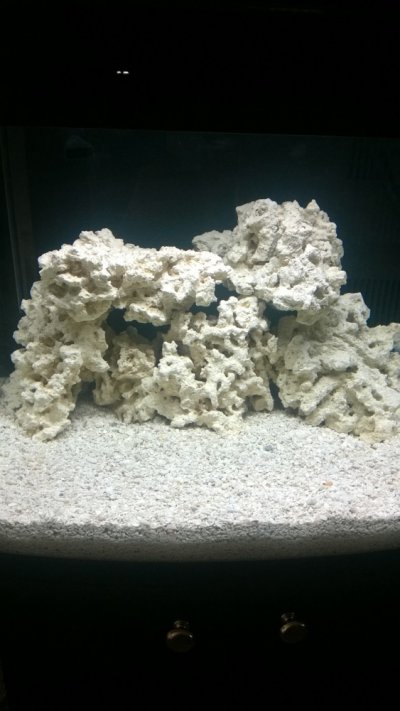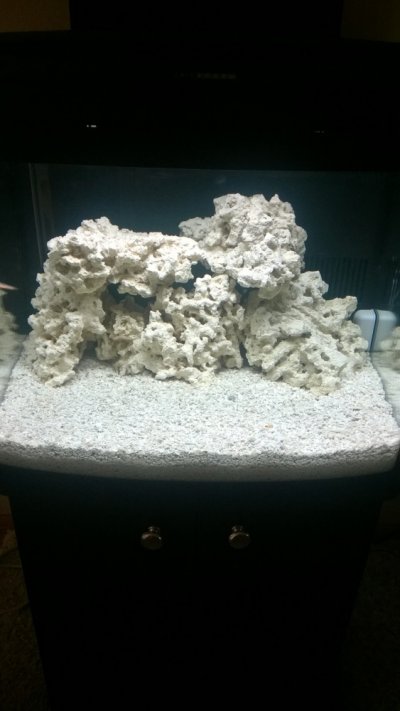sharlotte_g
Aquarium Advice Apprentice
Hi. I'm a newby, I'm talking right out of the womb, new. I've never had a fish tank before and now I'm in the process of setting up a sw tank. Thank goodness for the thread that shows all the acronyms because..whew.. I was lost, and to be honest, still am.
Okay. So far:
Day 1: May 5- I have a 29g Coralife Biocube. I've set it up and put a 20lb bag of live sand in it and then on top of that a 20lb bag of live crushed shells. Then I used 5 gallon buckets to fill with tap water and poured in the salt and mixed it in each bucket before pouring it in to the tank. I was able to fit 20 gallons of water and it is still a little bit above the "max" fill line. I thought that only 20g was due to the fact that I have 40lbs of sand/shells. Right?
Next, I added a full 3.38 oz bottle (says for 30g tanks) of Instant Ocean BIO-Spira Water Treatment.
I have a submersible heater that maintains temp at 78F (not changeable) in the tank and a shock absorber stick. Both are on the inside of my tank, not the back part that you can't see. Not sure if I can put those in there or not?? I will be adding the protein skimmer in the empty back compartment. The other two compartments contain the water pump and the filter and carbon cartridges.
Day 2: I poured 3 caps full (30ml) of API Stress Coat Marine Fish & Tap Water conditioner.
Next, cleaned the inside of the glass with a sponge since could see the different level water marks from pouring in the buckets. It easily wiped off.
Then, I ordered an Aquatic Life 115 mini Internal Protein Skimmer/Filter, 30 gallon. It will arrive today (5/8/14)
Day 4: Here I am.. just sand and water in the tank.
Supplies: The only other thing I have is the Instant Ocean Hydrometer salt tester.
Questions: (so many)
1.) what other testing kits do I need? I know there are like ph levels and nitrite/nitrate levels to test? Calcium? Magnesium? Oh boy.. so many..not sure which one's I need?
2.) I want to purchase live rock now. I have read so many different things that say what is what but still unsure of what I want/need for my little tank? I have read that Tonga Kaelini is good so how many pounds for a 29g?
3.) If you have live rock, is that considered a reef?
4.) I want to have fish and coral to make it pretty. . . and some anemones?
5.) I believe my next step is to buy rock. Do I buy two different kinds at same time and put them in tank same time or only introduce one kind of rock to the tank at once?
6.) Opinions about best online sites to buy live rock? Kaelini and the shelf kind..I believe the fish like caves and holes to hide in so if I mix those two it should be good for fish and to put coral on?
Oh boy.. I have a thousand more questions but I'll stop here. I just need to get to my next step which is the rock and test kits....
Please help me.. I'm clueless but I want to learn as much CORRECT information as I can in hopes of being an expert some day down the road...far far down the road. LOL
Suggestions are needed please to help guide me.
Thanks!
Okay. So far:
Day 1: May 5- I have a 29g Coralife Biocube. I've set it up and put a 20lb bag of live sand in it and then on top of that a 20lb bag of live crushed shells. Then I used 5 gallon buckets to fill with tap water and poured in the salt and mixed it in each bucket before pouring it in to the tank. I was able to fit 20 gallons of water and it is still a little bit above the "max" fill line. I thought that only 20g was due to the fact that I have 40lbs of sand/shells. Right?
Next, I added a full 3.38 oz bottle (says for 30g tanks) of Instant Ocean BIO-Spira Water Treatment.
I have a submersible heater that maintains temp at 78F (not changeable) in the tank and a shock absorber stick. Both are on the inside of my tank, not the back part that you can't see. Not sure if I can put those in there or not?? I will be adding the protein skimmer in the empty back compartment. The other two compartments contain the water pump and the filter and carbon cartridges.
Day 2: I poured 3 caps full (30ml) of API Stress Coat Marine Fish & Tap Water conditioner.
Next, cleaned the inside of the glass with a sponge since could see the different level water marks from pouring in the buckets. It easily wiped off.
Then, I ordered an Aquatic Life 115 mini Internal Protein Skimmer/Filter, 30 gallon. It will arrive today (5/8/14)
Day 4: Here I am.. just sand and water in the tank.
Supplies: The only other thing I have is the Instant Ocean Hydrometer salt tester.
Questions: (so many)
1.) what other testing kits do I need? I know there are like ph levels and nitrite/nitrate levels to test? Calcium? Magnesium? Oh boy.. so many..not sure which one's I need?
2.) I want to purchase live rock now. I have read so many different things that say what is what but still unsure of what I want/need for my little tank? I have read that Tonga Kaelini is good so how many pounds for a 29g?
3.) If you have live rock, is that considered a reef?
4.) I want to have fish and coral to make it pretty. . . and some anemones?
5.) I believe my next step is to buy rock. Do I buy two different kinds at same time and put them in tank same time or only introduce one kind of rock to the tank at once?
6.) Opinions about best online sites to buy live rock? Kaelini and the shelf kind..I believe the fish like caves and holes to hide in so if I mix those two it should be good for fish and to put coral on?
Oh boy.. I have a thousand more questions but I'll stop here. I just need to get to my next step which is the rock and test kits....
Please help me.. I'm clueless but I want to learn as much CORRECT information as I can in hopes of being an expert some day down the road...far far down the road. LOL
Suggestions are needed please to help guide me.
Thanks!


